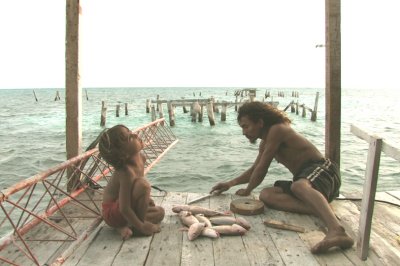Reviews - Alamar
Alamar
Reviewed By John Stakes

Alamar
The underworld of water featured strongly in both the “short” support and the main film last Sunday. First, club member John Walker, with over thirty years’ experience of filming underwater, took us to the other side of the world to reveal the marine life to be found off the coasts of the Galapagos Isles, Australia and Fiji.
For the main film we were whisked from Rome to the Caribbean. Director Pedro Gonzales-Rubio (34) was born in Belgium of Mexican parents and spent much of his life in India. So it’s hardly surprising that the themes of belonging and relationship bonding centred in his third film Alamar.
It proved to be a quietly absorbing, sensitive little piece lasting only some 73 minutes but what a simple, elegant, minimalist and even perplexing experience. It was both a documentary and a slice of fiction. Natan, a five year old boy now living with his Italian mother near Rome, comes to spend his summer holidays with his Mexican father Jorge, a guide living in a Mexican village in the wilds of the Yucatan Peninsula. His parents had met when his mother had visited Mexico as a tourist but
separated some three and a half years after Natan’s birth when they realised that neither could share the other’s lifestyle. There appeared to be no friction between them and they’d been able to make arrangements enabling Natan to see his father.
Roberta, the boy’s mother, plays little part in the film which concentrates on the relationship between father and son and the lad’s paternal grandfather Matraca, anageing but agile fisherman. We know nothing about the nature and quality of Natan’s relationship with his father before the visit but he seemed readily comfortable to be with his father. Jorge and Natan journey by bus to the coast and beyond to an island in the Banco Chincherro, a beautiful barrier reef to stay in a stilted wooden shack the summer home of Jorge’s father. There Natan learns to fish for lobster, snapper and
barracuda, and to snorkel whilst avoiding the attentions of the local crocodile. He is also taught to gain the trust of a white cattle-egret, and it is the passing on of the combined skills of Jorge and his father which cements Natan’s relationship with his father.
Gonzales plots and stages these events as a work of fiction, but the main characters (who may or may not have had any previous acting experience) play themselves and perform as if they are living in real time and space, so we feel we are watching a documentary. When he is asked about what he will remember most about his experiences Natan includes reference to the camera thereby introducing a touch of life imitating art and underlining the film’s documentary feel.
There is not much in the way of script to Gonzales-Rubio’s film and what there is seemed improvised. The director relies heavily on the maxim that visuals can often convey more than mere words. And indeed the cinematography is stunning, not merely displaying the beauty of the crystal clear Caribbean above and below water, but presenting it as a metaphor for the boy’s innocence and purity of imagination. It looks idyllic and even a threatening storm never materialises. Natan’s experiences will live long in his memory and perhaps that is the fundamental point of the film: that
absent father Jorge has but little time to spend with his son, and, not knowing when he might see him again, wishes to instil into the lad a lasting memory of his father and grandfather in addition to giving him an exciting adventure.
Three generations are thus briefly bound together in this shared exercise, the transient nature of which is exemplified in the closing sequences when Natan puts his drawings in a bottle which he tosses overboard, and, when he is back with his mother, blows a soap bubble into the air which bursts to end the film.
Alamar was made for a relative pittance using a two-person crew and one HD cameraman. It has gone on to win best film at the 2010 Rotterdam Film Festival and Gonzales-Rubio (who also wrote, edited and produced the film) won best new director award at the 2010 San Francisco Film Festival. His earlier credits were for two male-orientated documentaries. He is now in the process of making a film about
female love where no doubt his appreciation of the simplicity of beauty will feature strongly. In the meantime, in January, in the faraway rain-soaked town of Keswick, another large and appreciative audience could at least bask in the warm delightful after glow of the sun-kissed Caribbean!
For the main film we were whisked from Rome to the Caribbean. Director Pedro Gonzales-Rubio (34) was born in Belgium of Mexican parents and spent much of his life in India. So it’s hardly surprising that the themes of belonging and relationship bonding centred in his third film Alamar.
It proved to be a quietly absorbing, sensitive little piece lasting only some 73 minutes but what a simple, elegant, minimalist and even perplexing experience. It was both a documentary and a slice of fiction. Natan, a five year old boy now living with his Italian mother near Rome, comes to spend his summer holidays with his Mexican father Jorge, a guide living in a Mexican village in the wilds of the Yucatan Peninsula. His parents had met when his mother had visited Mexico as a tourist but
separated some three and a half years after Natan’s birth when they realised that neither could share the other’s lifestyle. There appeared to be no friction between them and they’d been able to make arrangements enabling Natan to see his father.
Roberta, the boy’s mother, plays little part in the film which concentrates on the relationship between father and son and the lad’s paternal grandfather Matraca, anageing but agile fisherman. We know nothing about the nature and quality of Natan’s relationship with his father before the visit but he seemed readily comfortable to be with his father. Jorge and Natan journey by bus to the coast and beyond to an island in the Banco Chincherro, a beautiful barrier reef to stay in a stilted wooden shack the summer home of Jorge’s father. There Natan learns to fish for lobster, snapper and
barracuda, and to snorkel whilst avoiding the attentions of the local crocodile. He is also taught to gain the trust of a white cattle-egret, and it is the passing on of the combined skills of Jorge and his father which cements Natan’s relationship with his father.
Gonzales plots and stages these events as a work of fiction, but the main characters (who may or may not have had any previous acting experience) play themselves and perform as if they are living in real time and space, so we feel we are watching a documentary. When he is asked about what he will remember most about his experiences Natan includes reference to the camera thereby introducing a touch of life imitating art and underlining the film’s documentary feel.
There is not much in the way of script to Gonzales-Rubio’s film and what there is seemed improvised. The director relies heavily on the maxim that visuals can often convey more than mere words. And indeed the cinematography is stunning, not merely displaying the beauty of the crystal clear Caribbean above and below water, but presenting it as a metaphor for the boy’s innocence and purity of imagination. It looks idyllic and even a threatening storm never materialises. Natan’s experiences will live long in his memory and perhaps that is the fundamental point of the film: that
absent father Jorge has but little time to spend with his son, and, not knowing when he might see him again, wishes to instil into the lad a lasting memory of his father and grandfather in addition to giving him an exciting adventure.
Three generations are thus briefly bound together in this shared exercise, the transient nature of which is exemplified in the closing sequences when Natan puts his drawings in a bottle which he tosses overboard, and, when he is back with his mother, blows a soap bubble into the air which bursts to end the film.
Alamar was made for a relative pittance using a two-person crew and one HD cameraman. It has gone on to win best film at the 2010 Rotterdam Film Festival and Gonzales-Rubio (who also wrote, edited and produced the film) won best new director award at the 2010 San Francisco Film Festival. His earlier credits were for two male-orientated documentaries. He is now in the process of making a film about
female love where no doubt his appreciation of the simplicity of beauty will feature strongly. In the meantime, in January, in the faraway rain-soaked town of Keswick, another large and appreciative audience could at least bask in the warm delightful after glow of the sun-kissed Caribbean!
Find A Film
Search over 1475 films in the Keswick Film Club archive.
Friends
KFC is friends with Caldbeck Area Film Society and Brampton Film Club and members share benefits across all organisations
Awards
Keswick Film Club won the Best New Film Society at the British Federation Of Film Societies awards in 2000.
Since then, the club has won Film Society Of The Year and awards for Best Programme four times and Best Website twice.
We have also received numerous Distinctions and Commendations in categories including marketing, programming and website.
 Talking Pictures
The KFC Newsletter
Talking Pictures
The KFC Newsletter
Links Explore the internet with Keswick Film Club


